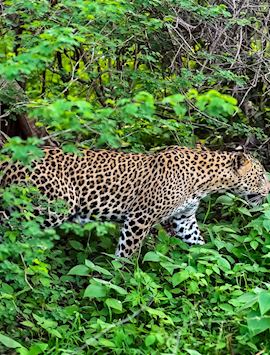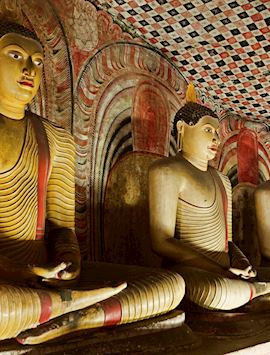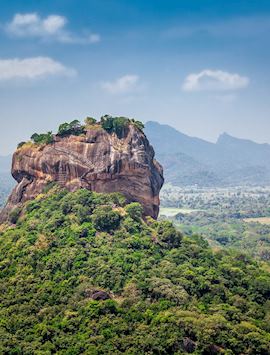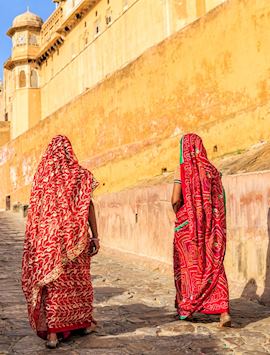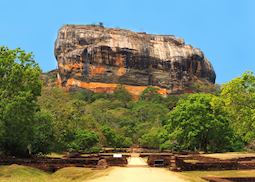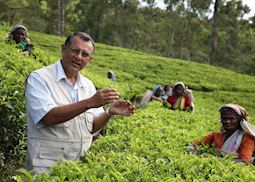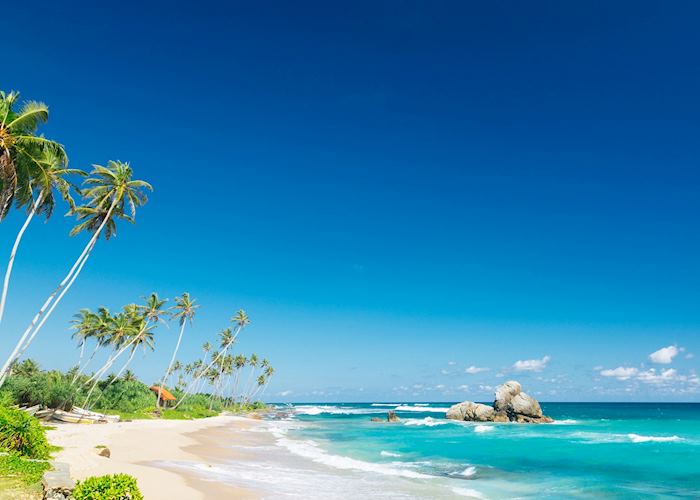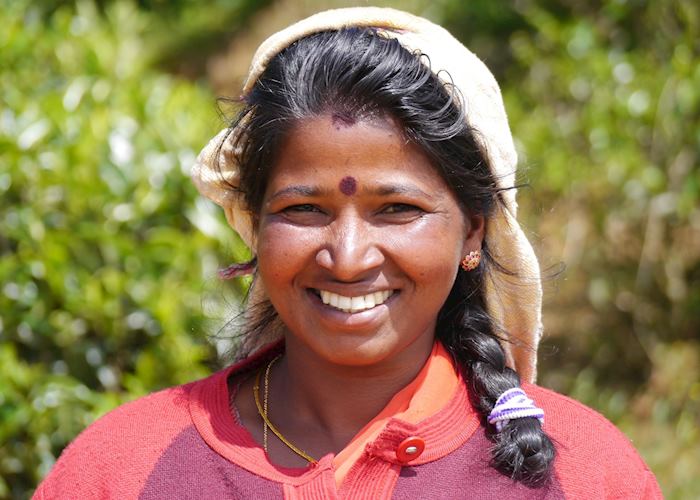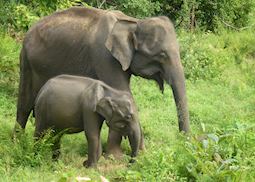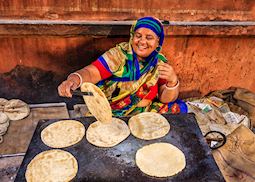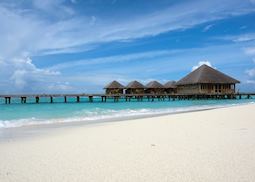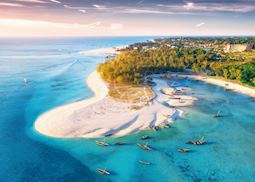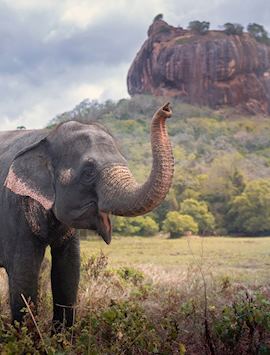

Tailor-made Sri Lanka vacations shaped around your passions
The cultural triangle, neatly tended tea estates, rose-gold beaches... On a tailor-made vacation to Sri Lanka with Audley, you’ll see the highlights — and much more — your way. We’ll design your ideal trip with you, paying close attention to your interests, your travel style and your budget. Our Sri Lanka specialists know the country inside out and can lead you to experiences you won’t find in a guidebook.
Admire the cave frescoes of Dambulla and clamber to the top of Sigiriya Rock’s fortress. Join pilgrims as they stroll the ruins of the ancient city of Polonnaruwa. Pause at a roadside fruit stall for a fresh banana. Spot elephants, birdlife and, if you’re lucky, a leopard, in Yala National Park. Take a traditional mask-making class and compare your skills with those sold in the boutiques of Dutch-colonial Galle.
Long stretches of coastline, Colombo’s artisanal markets, a plantation-home stay… What excites you? Travel at your own pace, in your own style, with the confidence that we’ll show you the best options, wherever you go.
Suggested tours for Sri Lanka
Soft-sand beaches, convivial culture, and wildlife-spotting opportunities: these are just some of the things we can include on your trip to Sri Lanka. We can help you explore the world-famous Cultural Triangle, or combine your time with a stay on a secluded island in the Maldives.
Suggested activities for Sri Lanka
Take in the picturesque railway journey to Nuwara Eliya, search for leopards in Yala National Park , or marvel at the intricate costumes during a traditional Kandyan dance performance. Whatever inspires your trip to Sri Lanka, we can recommend experiences that will show you the country in a new light.
-
Yala National Park jeep safari ![Bee-eater in the Yala National Park]()
Yala National Park jeep safari
Yala National ParkYala National Park jeep safari
You can hope to see many species of birds including storks, kingfishers and peacocks. The animals residing in the park include crocodiles, elephants and buffalo.
View details -
Sigiriya Rock Fortress tour ![Sigiriya Rock Fortress]()
Sigiriya Rock Fortress tour
SigiriyaSigiriya Rock Fortress tour
You will start your day by visiting the mighty Sigiriya Rock Fortress which dominates the surrounding landscape. For many visitors, this is the most impressive site in Sri Lanka with stunning views from the top.
View details -
Nuwara Eliya tea estate visit ![Visit to a tea plantation, Hatton]()
Nuwara Eliya tea estate visit
Nuwara EliyaNuwara Eliya tea estate visit
Driving through the twisting roads of the tea estate, you see the colorful women, mainly of Tamil origin, at work in the plantations.
View details
Why travel with Audley?
- 100% tailor-made tours
- Fully protected travel
- Established for over 25 years
- 98% of our clients would recommend us
Best time to visit
Our specialists advise on the best months to visit Sri Lanka, including information about climate, events and festivals.
Request our brochure
Covering all seven continents, The World Your Way shows you how you can see the world with us. It features trip ideas from our specialists alongside hand-picked stays and experiences, and introduces our approach to creating meaningful travel experiences.
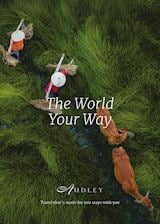
Useful information for planning your vacation in Sri Lanka
The official languages of Sri Lanka are Sinhala and Tamil. English is widely spoken. Place names and signs are in English and Sinhala, English and Tamil, or sometimes all three.
The currency of Sri Lanka is the Sri Lankan rupee (Rs or LKR). ATMs are common and usually offer the best exchange rate if you choose to be charged in rupees. Credit cards are also widely accepted, but you’ll need cash to pay in smaller towns and markets.
Currency should only be changed at banks or at official money changers. Avoid uncertified money traders on the street and try to get cash in smaller denominations as change can be hard to come by. You should re-convert all remaining rupees before leaving Sri Lanka.
Hoppers (bowl-shaped pancakes), kottu (chopped roti with shredded vegetables, meat, and spices), and polos (green jackfruit curry) are popular Sri Lankan dishes. The translation ‘curry’ is a catch-all for a huge variety of sauces popular in Sri Lanka, some fiery, others mild and aromatic.
For example, ambul thial is a sour fish curry typical in the south, while Jaffna curries from the north are rich and robust. Vegans and vegetarians will find plenty of options such as mallung, a dish prepared with grated coconut, shredded kale, red onions, and lime.
You’ll find fresh, tropical fruit in all the markets, including local treats such as wood apple smoothies.
A 10% tip in restaurants is appreciated, even if a service charge has been added to your total. Drivers, guides, and hotel porters will also expect a tip. Your specialist can advise on appropriate amounts closer to your travel dates. Tips in US dollars and British sterling are particularly welcomed.
For the latest travel advice for Sri Lanka, including entry requirements, health information, and the safety and security situation, please refer to the State Department website.
From spice and tea plantations to national parks thronged with elephants, historic cities, and relaxing coastal resorts, Sri Lanka offers myriad experiences in a relatively small destination. Wherever you go, you’ll find richly historic cities with streets lined with heritage architecture, ancient palaces, gilded temples, and lively markets.
Historical highlights include a sunrise visit to Sigiriya Rock Fortress and a chance to explore Sri Lankan Buddhism in the Dambulla cave temples. You could escape the heat and take the tea-plantation train through terraced hillsides to the misty highlands, go birdwatching in a biosphere reserve, or take a jeep safari on the trail of leopards or elephants.
If you’d prefer something more active, you can go white-water rafting on the Kelaniya Ganga, go whale watching off the south coast, or hike through the moorlands at Horton Plains. And once you’ve done the sights, golden beaches lapped by gentle seas await.
Sri Lanka offers a great range of hotels from historic city hideaways to beach villas, tea planters’ bungalows, and sleek, designer boutique hotels. You’ll find the greatest choice of places to stay in the cities and more established destinations.
In cities such as Galle, there are many historic hotels to choose from, you’ll find indulgent boutique guesthouses on working tea plantations, and everything from suites with private pools and views of the jungle or to simple tented camps in and around the national parks.
If you aim to finish your trip with some time relaxing on the beach, you can choose from luxurious resorts or yoga and spa retreats on the south coast. For more ideas, browse our collection of places to stay in Sri Lanka.
Some of Sri Lanka’s most popular destinations include Galle, Kandy, the Cultural Triangle, and the national parks. Most visitors arrive in Colombo, Sri Lanka’s cosmopolitan capital where neo-classical buildings butt up against glittering skyscrapers and traditional markets.
You could see the ruins of a 5th-century palace at Sigiriya, explore the botanical gardens and temples of the former capital Kandy, then make your way into the cooler hills to visit the tea plantations around Nuwara Eliya.
For wildlife, Yala National Park offers the chance to spot the elusive leopard, while you’ll find beautiful beaches on the south coast along with the UNESCO-protected fortified city of Galle where the narrow lanes are steeped in history.
Leopards are the big attraction in Sri Lanka, but you’ll also get the chance to spot herds of elephants, water buffalos, toque monkeys, and a vast array of birdlife. One of Sri Lanka’s most renowned wildlife experiences is ‘The Gathering’ at the Minneriya Tank between July and August, when hundreds of elephants congregate around the permanent water source.
Yala National Park has highest concentration of leopards in the world and is a great place to try spotting this elusive creature, but the park is also home to sloth bears and sambar deer. Elsewhere, you might spot jackals, crocodiles, or purple-faced langurs, and in Bundala National Park almost 200 bird species make their homes in the forests, lagoons, and waterways.
For more information on where to go and what you might see, take a look at our guide to Sri Lankan wildlife.
You’ll need to bring a variety of clothing to Sri Lanka. For example, light, loose, cotton clothing is good for lowland areas that are hot and humid, but you’ll need a fleece and jeans for the cooler nights in the highlands.
When visiting temples, you’ll need to dress respectfully with shoulders and knees covered, and during the monsoons (October to January and May to August), a raincoat or an umbrella is a must. If you’re planning to go trekking or rafting, you’ll need good walking shoes or boots, thick socks, and clothing that covers your legs to your ankles to thwart the local leeches, which are quite common.
It takes around 19 hours to fly from the East Coast of the US to Sri Lanka, and around 22 and a half hours from the West Coast.
The time zone in Sri Lanka is UTC+5:30 hours. Daylight Savings Time isn’t observed.
The best way to get around in Sri Lanka is by car. We can arrange for a private chauffeur-guide to take you between destinations and act as your local expert while there. Along with an insight into Sri Lankan life, your guide can also give you historical context on things you see, offer suggestions on where to find authentic Sri Lankan food, and ensure you’re aware of Sri Lankan customs you should observe.
In places, Sri Lanka’s trains are also worth experiencing, such as the train between Kandy and Ella, which offers a comfortable journey through lush, terraced hills past waterfalls and tea plantations.
Your doctor is best placed to offer immunization advice for Sri Lanka. You can check suggested vaccinations on the Centers for Disease Control and Prevention website, and should also ensure you’re up to date with routine vaccinations at home.
Sri Lanka in pictures
Our expert guides to traveling in Sri Lanka
Written by our specialists from the viewpoint of their own travels, these guides will help you decide on the shape of your own trip to Sri Lanka. Aiming to inspire and inform, we share our recommendations for how to appreciate Sri Lanka at its best.
-
![My travels in Kerala & Sri Lanka]()
My travels in Kerala and Sri Lanka
Visiting Kerala and Sri Lanka, Indian Subcontinent specialist Matt captured this video footage on his trip.
-
Sri Lanka’s wildlife: safaris, jungles and plains ![Mother and baby elephants in the wild]()
Sri Lanka’s wildlife: safaris, jungles and plains
Sri Lanka’s wildlife: safaris, jungles and plains
An avid wildlife enthusiast, Sri Lanka specialist Seamus explains where to spot Sri Lanka’s leopards, sloth bears and elephants. He also shares his recommended experiences away from the usual parks, such as walking through primary rainforest and taking boat rides across secluded lakes.
Read this guide -
Luxury Sri Lanka vacations: from colonial grandeur to palm-fringed shores ![Summer house at Norwood Bungalow]()
Luxury Sri Lanka vacations: from colonial grandeur to palm-fringed shores
Luxury Sri Lanka vacations: from colonial grandeur to palm-fringed shores
Luxury in Sri Lanka can take the form of a palatial beach-front suite, secluded colonial cottage or a safari tent. Sri Lanka specialist Sophie shares her suggestions for the most comfortable stays and exclusive experiences, including tea tasting with a master tea specialist or a chartered flight across the coastline.
Read this guide -
What to do in Sri Lanka: our highlights guide ![Buddha statues in the Dambulla Cave Temples]()
What to do in Sri Lanka: our highlights guide
What to do in Sri Lanka: our highlights guide
With impressive cultural sites, delightful beaches and wildlife viewing opportunities within its many parks, Sri Lanka offers a diverse mix of experiences, which can easily be combined in a two-week trip.
Read this guide -
Slow down in Sri Lanka: a leisurely tour of the north ![Vallipuram Alvar Kovil temple, Jaffna]()
Slow down in Sri Lanka: a leisurely tour of the north
Slow down in Sri Lanka: a leisurely tour of the north
Trips to Sri Lanka can often be rushed, but it pays to slow down the pace, says Sri Lanka specialist Chloe. On an unhurried tour of Sri Lanka’s little-visited north, there’s time to really get to know a region that, although marred with the scars of war, welcomes visitors warmly.
Read this guide
Other popular destinations
Still looking for ideas? If Sri Lanka has captured your interest, we think you might also like these destinations.
